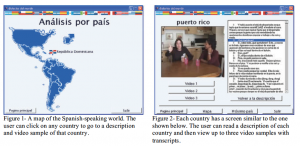Jonathan Whiting and Dr. Orlando Alba, Spanish and Portuguese
At least twenty countries on three different continents recognize Spanish as an official language and this doesn’t include countries like the United States that still have a sizeable Spanish-speaking population. With so much ethnic and geographic diversity in the Spanish-speaking world, it is only natural to expect a great deal of linguistic diversity as well.
The purpose of this project was to create a software program that would give college level Spanish students an opportunity to see and hear samples of Spanish from the above-mentioned twenty countries. Part of my project was to record on video up to three samples each from as many of these countries as possible and pair this recording with a transcript. Using these recordings, I then intended to create a software program that would organize the video recordings and transcripts in a logical and easy to use manner. This was, in retrospect, far too intensive a project for such a short period of time. Although I was able to make great strides, I did not complete the project.
There were several factors that kept me from completing this project. First, I did not anticipate the amount of time required to obtain permission to video tape human subjects from the Institutional Review Board (IRB). While applying for this scholarship, I was led to believe that IRB approval was a simple process with a wait of no more than two weeks, a process that I should not begin until after being notified of my acceptance by ORCA. The wait was longer than six weeks; it was nearly March before I could begin a project that I was to complete by April.
The second factor was the decision to design the program using a new, unfamiliar authoring tool. After consulting with several professors in the Computers and Humanities (CHum) program, I decided to use a new authoring tool called Runtime Revolution to create the program. Although the tool had a fairly shallow learning curve, it still had many bugs and I had little time to familiarize myself with the product. This project would have been impossible without the help of CHum department Professor Devin Asay.
Third and probably paramount, I underestimated this project’s complexity. I did not allow for many of the steps in the creation process. More than anything, this was because I was unfamiliar with the process of creating a program from start to finish, a process which can only be truly learned through experience.
Although I was not able to complete the project, I am satisfied with the work I did complete. I was able to record almost twenty samples and create a working, although not complete, multimedia program. The program was specifically engineered so that it will be easy to add more recordings at a later time without rewriting the program. All the video clips, descriptions, transcripts, questions etc. are stored externally, and can be edited with no more than a basic knowledge of word processing and video editing. A built in editing tool designed to help make this process even more automated was begun but not completed.
In the current version, the user is presented with a map of the Spanish-speaking world (Fig. 1). By clicking on any country, the user goes to a page which gives a description of the country, provides a video and the corresponding transcript (Fig. 2).
More important than the completion of this project was the experience I gained while working through the design and development process. This project served as my first exposure to the role of technology in education and the importance of sound instructional principles. While working on this project, I became so intrigued by this process that I decided to pursue an advanced degree in the field of Instructional Technology. I am currently working towards a Masters degree in Instructional Technology at Utah State University and plan to apply many of the skills I learned during this project to future programs.

